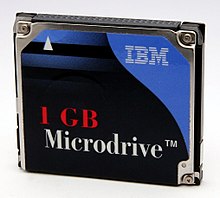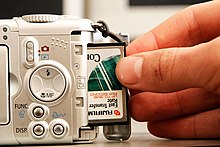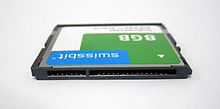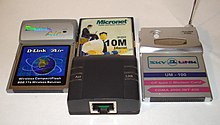CompactFlash
| Storage medium CompactFlash
|
|
 Three views of a CompactFlash Type I card |
|
| General | |
|---|---|
| Type | Semiconductor memory |
| capacity | up to 512 GB (CF5.0: up to 128 PiB) |
| lifespan | Read unlimited, write 10,000 to 2 million cycles |
| size | Type I: 36.4 mm × 42.8 mm × 3.3 mm Type II: 36.4 mm × 42.8 mm × 5.0 mm |
| use | higher quality DSLRs |
| origin | |
| developer | SanDisk |
| Launch | 1994 |
CompactFlash ( CF ) is an interface standard, including for digital storage media . In the form of CF cards, it is mainly used in digital cameras , but also in network components, computers and personal digital assistants (PDA).
construction
In contrast to hard disks or CD drives, CompactFlash memory cards are usually storage media without moving parts. The information is permanently stored on a rewritable flash memory . In the meantime, however, IBM produced CF-II cards with small hard drives as a storage medium. This product became known under the name Microdrive and had the advantage of a better price-performance ratio. Later there were other manufacturers of hard disk-based CF cards. However, due to the drop in the price of flash memory, these solutions practically disappeared from the market between 2005 and 2006.
In addition to the actual memory chip, CompactFlash cards with flash memory also have a controller that manages the memory and offers an (E) - IDE interface to the outside world , which differs from conventional IDE interfaces in the shape of the connector. In contrast to all other flash-based memory cards, with the exception of the SD card, the card-internal controller and not the end device (such as the digital camera) is responsible for addressing the actual memory. The rather complicated details of the flash memory control therefore remain hidden from the host device. If there is support from the memory for a file system that can address more memory (such as FAT32 versus FAT16), CF cards with high capacity can also be read by old devices. The contacts are protected.
distribution
In digital storage media (for digital cameras), CompactFlash technology was the market leader for a long time because of its high speed, but has been increasingly superseded by the SecureDigital Card (SD) since the late 2000s . In 2020, professional digital SLR cameras will generally no longer support CompactFlash cards. For older camera models with CF memories, an adapter from Compact Flash to Micro SD can be used.
application areas
CompactFlash cards are the most common storage medium in digital cameras, especially in the professional field such as press photography. Even professional digital mobile audio recording almost always works with CompactFlash if no hard drive or disc systems are used for reasons of space, energy or weather.
In the plotter for recreational boating today CompactFlash cards are by default used as storage media.
Since they have no moving parts, CompactFlash cards are relatively insensitive to impact and are therefore suitable for use in industrial or mobile systems. They are often used there as the only permanent memory. The industrial computers of some manufacturers can optionally be configured with a permanently integrated CompactFlash slot or IDE port. In this case, the CompactFlash card is usually repartitioned and formatted with a different file system than the one supplied as standard. This is common practice for Linux or QNX systems.
adapter
Other cards after CompactFlash
There are adapters for the CompactFlash slot that can be used with other memory cards. Multimedia cards , SDHC and micro SDXC memory cards , for example, can be used in devices with CompactFlash slots. In terms of backward compatibility to smaller memory cards, CompactFlash has the greatest flexibility for future memory sizes, because only the controller of the adapter used and the size of the card used limit the usable memory size. There are limitations with older devices, as some of them only support FAT16 and thus limit the capacity of the memory card to 8/16 GB in terms of software.
CompactFlash according to IDE
Since the CompactFlash card has an IDE interface, a passive adapter (i.e. a piece of circuit board with cables that connect the contacts of the card to the corresponding pins of an IDE connector) is sufficient to be able to use it instead of an IDE hard disk ( see comparison ). In desktop computers, the adapter also requires a connector to power the card, which the IDE ribbon cable used there lacks. Because the 44-pin version of the IDE interface of notebooks provides a power supply, it can be used in place of a hard disk or with a PC card / PCMCIA adapter without an additional power supply. The power supply is also integrated in the 40-pin ZIF cable, which in some subnotebooks connects to the hard drive or SSD.
Some cards identify themselves as removable media, which causes some operating systems and programs to refuse to be installed on them. This identifier can be changed for some cards.
Standards
Designs
- CF Type I (36.4mm × 42.8mm × 3.3mm)
- CF Type II (36.4 mm × 42.8 mm × 5.0 mm), sometimes referred to as " Microdrive- compatible", since all Microdrives are Type II cards.
The only difference is the thickness of the design. Therefore, Type I cards also work in a Type II slot.
interface
While the external shape remained unchanged, the CF standards were adapted to evolving capacities and bandwidths.
- CompactFlash 1.0 (1994/1995)
- 8.3 MB / s ( PIO Mode 2)
- 128 GB (137 GB) possible capacity, as with IDE
-
CompactFlash + , also CompactFlash I / O (1997)
- Cards that do not have a memory function, but enable radio reception, for example.
- CF + and CompactFlash 2.0 (2003)
- CF + and CompactFlash 3.0 (2004)
- CF + and CompactFlash 4.0 (2006)
- 133 MB / s ( UDMA 133 )
- Card can be password protected
- CF + and CompactFlash 4.1 (2007)
- Advanced energy saving modes
- CompactFlash 5.0 (2010)
- 48-bit sector addressing via LBA-48 (mandatory). This removes the previous limit of 128 GiB (137 GB). Cards can theoretically hold up to 128 PiB (144 PB). In addition, acceleration by transferring blocks of up to 32 MiB instead of the previous 128 KiB blocks.
- Trim command (required). Accelerates write access.
- ATA command set ATA-6 & ATA-8 / ACS-2 (optional). Adaptation to the progress of the ATA standard
- Power control (optional). Guaranteed certain transfer rates (important for live streaming or video recordings)
- Transmission of the CF version number (mandatory). In this way, the CF device can more easily adapt to the capabilities of the card.
- Changed electrical specifications (mandatory) to improve compatibility with the ATA standard.
- CompactFlash 6.0 (November 18, 2010)
The above standards are upwards and downwards compatible.
CFast
The faster SATA protocol is used with the CFast standard. The connections of these cards are not compatible with the classic CompactFlash cards.
- CompactFlash ATA Serial Transfer (CFast) 1.0 (2008)
- 300 MB / s ( Serial ATA 3.0 Gbit / s )
- Hot swap
- same housing dimensions as before, but not compatible with CompactFlash
- normal SATA data connection, proprietary power connection
- first products at the end of 2009
- CompactFlash ATA Serial Transfer (CFast) 2.0 (2012)
- 600 MB / s ( Serial ATA 6.0 Gbit / s )
- new case dimensions, especially flatter
- first products planned for 2013
CFexpress
The logical further development, which is neither mechanically nor electrically compatible with the CompactFlash interface, but is based on PCIe 3.0 and NVMe, is CFexpress. The standard was announced in September 2016 and published in April 2017.
Data from available CF cards
| Capacity: | 2 MByte … 256 GByte |
| File system: | The FAT12 file system was traditionally used for memory cards with less than 16 MB, FAT16 is usually used from 16 MB to 2 GB (more rarely for capacities up to 4 GB), and FAT32 is usually used for storage capacities of more than 2 GB (4 GB) . In principle, any other file systems can also be used. However, since the controllers in the cards usually map the externally visible hard disk emulation level onto the actual internal memory chip in such a way that a favorable distribution of wear is achieved with typical use of FAT12 / FAT16 / FAT32 ( wear leveling ), other file systems can reduce the life of the card. |
| Read: | 6…> 150 MByte / s ≙ 40 × to> 1000 × (1 × corresponds to 150 kByte / s, which is 1x CD reading speed .) |
| Write: | 4…> 125 Mbytes / s |
| Read access: | <1 ms |
| Write access: | 10 ... 35 ms |
| Connection: | 50 pins |
| Tension: | 3.3 V (± 5%) or 5 V (± 10%); All cards can be operated with both voltages. |
| Electricity: | Idle mode: 0.5… 1 mA write and read mode: 25… 50 mA |
| Operation at: | 0 ... 60 ° C |
| Storage at: | −40 ... 85 ° C |
| Shock resistance : | 2,000 g, microdrives 400 g |
| Write cycles: | 10,000 according to the standard, 1… 2 million according to the manufacturer. Some manufacturers integrate counters into the firmware of their cards in order to distribute the wear evenly across all sectors. Sectors that are used up are automatically marked as unusable. |
The information varies depending on the manufacturer and product series, so terms such as "Professional", "Ultra" and "Extreme" can denote different qualities. With the market leader SanDisk, Ultra cards achieve a transfer rate of over 30 MByte / s (read and write) and Extreme Pro models up to 100 MByte / s (read and write). Lexar introduced a model with up to 150 MB / s (read) in early 2012.
Depending on the manufacturer, the speed is declared either as a multiple of the reading speed of CD-ROM drives (with Kingston or Transcend) or with the maximum data transfer rate (with SanDisk). The base unit ("1 ×") is historically based on the basic speed of the CD-ROM drives, which achieve a transfer rate of 153.6 kB / s in CD-ROM mode 1 at 1x reading speed, whereby this value is 150 kB / s is rounded down. The following table compares the usual speed designations and maximum data transfer rates.
| Information (x-fold) |
Read speed (MB / s) |
|---|---|
| 6 × | 0.9 |
| 32 × | 4.8 |
| 40 × | 6.0 |
| 66 × | 10.0 |
| 80 × | 12.0 |
| 100 × | 15.0 |
| 133 × | 20.0 |
| 150 × | 22.5 |
| 200 × | 30.0 |
| 266 × | 40.0 |
| 280 × | 42.0 |
| 300 × | 45.0 |
| 433 × | 65.0 |
| 533 × | 80.0 |
| 600 × | 90.0 |
| 666 × | 100.0 |
| 800 × | 120.0 |
| 1000 × | 150.0 |
| 2000 × | 300.0 |
Other CF devices
With CF I / O, CompactFlash offers the option of connecting other devices in addition to memory. Due to the logical and mechanical similarity to the PC card standard , it is easy for manufacturers to offer the corresponding cards as CompactFlash variants. The CompactFlash slots of PDAs are used to 56K - GSM - and GPRS - modem and Bluetooth - Ethernet - and Wi-Fi adapters, GPS and - radio receivers, digital cameras, USB to connect -Host adapter and even graphics cards. Such adapters are usually designed in full, i.e. as CF type II.
Web links
- CompactFlash Association (English)
- CF memory card speed comparison April 20, 2013
- Maps and digital cameras in speed comparison July 12, 2012
- Electrical assignment of Compactflash 2006 (English)
Individual evidence
- ↑ Compact Flash card with 512 GB
- ↑ CFA: CF cards. CompactFlash Association, accessed July 11, 2017 .
- ^ Website of the German CF controller manufacturer Hyperstone
- ↑ Patent DE102005001038 : Method for converting logical to real block addresses in flash memories.
- ↑ Patent DE10349595 : Method for writing memory sectors in a memory that can be erased in blocks.
- ↑ Patent EP1514171 : Method for restoring administrative data records from a memory that can be erased in blocks.
- ↑ Delock Compact Flash adapter for SDHC / MMC memory cards ( Memento of the original from June 18, 2012 in the Internet Archive ) Info: The archive link was inserted automatically and has not yet been checked. Please check the original and archive link according to the instructions and then remove this notice.
- ↑ Delock Compact Flash Adapter> Micro SD memory cards ( Memento of the original from June 18, 2012 in the Internet Archive ) Info: The archive link was inserted automatically and has not yet been checked. Please check the original and archive link according to the instructions and then remove this notice.
- ↑ How to add RAM to the Acer Aspire One netbook ( Memento of the original dated February 6, 2010 in the Internet Archive ) Info: The archive link was inserted automatically and has not yet been checked. Please check the original and archive link according to the instructions and then remove this notice. , AspireOneUser.com, August 29, 2008
- ↑ CARDSPEED - UDMA CompactFlash cards , hjreggel.net, November 7, 2011
- ↑ CFast - Evolution of the CompactFlash Interface ( Memento of the original from December 5, 2008 in the Internet Archive ) Info: The archive link was inserted automatically and has not yet been checked. Please check the original and archive link according to the instructions and then remove this notice. (PDF) The CompactFlash Association, April 14, 2008
- ↑ First CFAST card ( memento of the original from January 4, 2012 in the Internet Archive ) Info: The archive link was inserted automatically and has not yet been checked. Please check the original and archive link according to the instructions and then remove this notice. of the Swissbit company
- ↑ CFast CompactFlash cards now said to be coming in “18 to 24 months” . Engadget, February 25, 2008
- ↑ photokina 2012 - SanDisk presents CFast 2.0 and gives XQD a rejection . ValueTech.de, September 19, 2012
- ↑ CeBIT 2013 - SanDisk Interview on CFast 2.0 . ValueTech.de, March 5, 2013.
- ↑ CFA 5.1 Press Release .
- ↑ CFexpress 1.0 Press Release .
- ↑ CompactFlash memory card with 256 GB , heise photo, January 9, 2012
- ↑ a b c Lexar brings CF cards with 1000 times the transfer speed , digitalkamera.de January 7, 2012
- ↑ SanDisk Ultra CompactFlash card ( memento of the original from October 24, 2012 in the Internet Archive ) Info: The archive link was inserted automatically and has not yet been checked. Please check the original and archive link according to the instructions and then remove this notice. , sandisk.de, accessed on August 27, 2012
- ↑ SanDisk Extreme Pro CompactFlash card 100MB / s ( Memento of the original from January 7, 2012 in the Internet Archive ) Info: The archive link was inserted automatically and has not yet been checked. Please check the original and archive link according to the instructions and then remove this notice. , sandisk.de, accessed on August 27, 2012







